|
|
 |
|
Calanoida ( Order ) |
|
|
|
Arietelloidea ( Superfamily ) |
|
|
|
Augaptilidae ( Family ) |
|
|
|
Augaptilus ( Genus ) |
|
|
| |
Augaptilus longicaudatus (Claus, 1863) (F,M) | |
| | | | | | | Syn.: | Hemicalanus longicaudatus Claus, 1863 (p.179, fig.) | | | | Ref.: | | | Giesbrecht, 1892 (p.400, 414, 770, figs.F,M); Giesbrecht & Schmeil, 1898 (p.123, Rem. F,M); Esterly, 1905 (p.188, figs.M, Rem.F,M); Farran, 1908 b (p.78, Rem.); A. Scott, 1909 (p.136, Rem.); Wolfenden, 1911 (p.341); Pesta, 1920 (p.533); Lysholm & Nordgaard, 1921 (p.26); Sars, 1925 (p.256, figs.F); Farran, 1926 (p.288); 1929 (p.209, 269); Sewell, 1932 (p.315); Farran, 1936 a (p.113); Jespersen, 1940 (p.57); Sewell, 1947 (p.232, Rem.); Brodsky, 1950 (1967) (p.367, figs.F,M, Rem.); Grice, 1962 (p.226, figs.F); Tanaka, 1964 b (p.79, figs.F); Vervoort, 1965 (p.131, Rem.); Owre & Foyo, 1967 (p.82, figs.F,M); Tanaka & Omori, 1971 (p.260, fig.F, Rem.); Matthews, 1972 (p.46, Rem.); Razouls, 1972 (p.95, Annexe: p.81); Ali-Khan & Ali-Khan, 1984 (p.303, figs.F); Mazzocchi & al., 1995 (p.25, Rem.); Bradford-Grieve & al., 1999 (p.882, 939, figs.F,M); Bradford-Grieve,1999 b (p.42, figs.F,M, Rem., figs.171, 190); Vives & Shmeleva, 2007 (p.173, figs.F,M, Rem.) |  issued from : O. Tanaka in Publs Seto Mar. Biol. Lab., 1964, XII (1). [p.80, Fig.213]. Female: a, habitus (dorsal); b, forehead (left lateral side); c, last thoracic segment and urosome (left lateral side); d, urosome (ventral); e, masticatory blade of Md; f, Mx1; g, P5. Nota: The urosome segments and furca are in the proportional lengths as 38:10:18:34 = 100. A1 exceeds the end of the furca by distal 4 segments.
|
 issued from : J.M. Bradford-Grieve in The Marine Fauna of New Zealand: Pelagic Calanoid Copepoda. National Institute of Water and Atmospheric Research (NIWA). NIWA Biodiversity Memoir, 111, 1999. [p.45, Fig.18]. Female: A, habitus (dorsal); B, caudal ramus; C, Mx1; D, Md (mandibular palp); E, P1; F, P5 (another specimen) Male: G, habitus (dorsal); H, P5 (L = left leg; R = right leg).
|
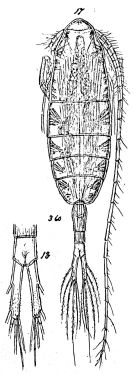 Issued from : G.O. Sars in Résult. Camp. Scient. Prince Albert I, 69, pls.1-127 (1924). [Pl.LXXVI, figs.17-18]. Female: 17, habitus (dorsal); 18, anal segment and caudal rami (dorsal).
|
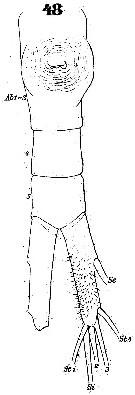 Issued from : W. Giesbrecht in Systematik und Faunistik der Pelagischen Copepoden des Golfes von Neapel und der angrenzenden Meeres-Abschnitte. – Fauna Flora Golf. Neapel, 1892. Atlas von 54 Tafeln. [Taf.39, Fig.48]. Female: 48, urosome (ventral).
|
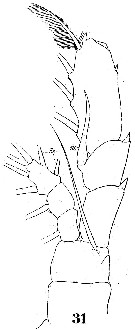 Issued from : W. Giesbrecht in Systematik und Faunistik der Pelagischen Copepoden des Golfes von Neapel und der angrenzenden Meeres-Abschnitte. – Fauna Flora Golf. Neapel, 1892. Atlas von 54 Tafeln. [Taf.27, Fig.31]. Female: 31, P5 (posterior view).
|
 issued from : C.O. Esterly in Univ. Calif. Publs. Zool., 1905, 2 (4). [p.188, Fig.41]. Male (from San Diego Region): a, habitus (dorsal); b, Mx2; c, right P5; d, left P5. Nota: Grasping A1 on left.
|
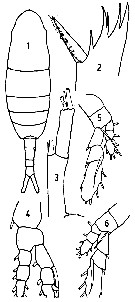 issued from : S. Ali-Khan & J. Ali-Khan in Crustaceana, 1984, 47 (3). [p.304, Figs.1-6]. Female (from 24°09'N, 64°27'E): 1, habitus (dorsal); 2, Md (biting edge); 3, Mx1; 4, P1; 5, left P5; 6, right P5. Nota: The mandibular dentition is 5 + 1 as in Tanaka (1964) but differs with that of Grice (1962). P5 is atypical since the outer edge of the 3rd exopoodal segment of left P5 has 2 spines while the right one has a single spine.
|
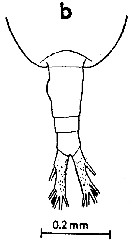 issued from : O. Tanaka & M. Omori in Publ. Seto Mar. Biol. Lab., 1971, XIX, 4. [p.260, Fig.5, b]. Female (from Izu Region): b, last thoracic segment and urosome (dorsal).
|
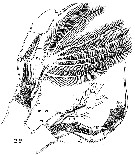 Issued from : W. Giesbrecht in Systematik und Faunistik der Pelagischen Copepoden des Golfes von Neapel und der angrenzenden Meeres-Abschnitte. – Fauna Flora Golf. Neapel, 1892. Atlas von 54 Tafeln. [Taf.29, Fig.22]. Male: 22, P5 (anterior view). Ps = left leg; Pd = right leg.
|
 Issued from : W. Giesbrecht in Systematik und Faunistik der Pelagischen Copepoden des Golfes von Neapel und der angrenzenden Meeres-Abschnitte. – Fauna Flora Golf. Neapel, 1892. Atlas von 54 Tafeln. [Taf.28, Fig.2]. Male: 2, left A1 (ventral view).
|
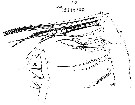 Issued from : W. Giesbrecht in Systematik und Faunistik der Pelagischen Copepoden des Golfes von Neapel und der angrenzenden Meeres-Abschnitte. – Fauna Flora Golf. Neapel, 1892. Atlas von 54 Tafeln. [Taf.28, Figs.31, 38, 39]. Male: 31, Mxp; 38, Mx2 (anterior view); 39, portion of Mx2 seta with ''buttons''.
|
 Issued from : W. Giesbrecht in Systematik und Faunistik der Pelagischen Copepoden des Golfes von Neapel und der angrenzenden Meeres-Abschnitte. – Fauna Flora Golf. Neapel, 1892. Atlas von 54 Tafeln. [Taf.28, Fig.8]. Female: 8, A1 (distal segments).
|
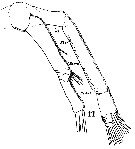 Issued from : W. Giesbrecht in Systematik und Faunistik der Pelagischen Copepoden des Golfes von Neapel und der angrenzenden Meeres-Abschnitte. – Fauna Flora Golf. Neapel, 1892. Atlas von 54 Tafeln. [Taf.28, Fig.11]. Female: 11, A2 (anterior view).
|
 Issued from : W. Giesbrecht in Systematik und Faunistik der Pelagischen Copepoden des Golfes von Neapel und der angrenzenden Meeres-Abschnitte. – Fauna Flora Golf. Neapel, 1892. Atlas von 54 Tafeln. [Taf.28, Fig.19, 23]. Female: 19, Md; 23, Md (biting edge of mandibular blade).
|
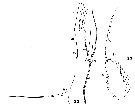 Issued from : W. Giesbrecht in Systematik und Faunistik der Pelagischen Copepoden des Golfes von Neapel und der angrenzenden Meeres-Abschnitte. – Fauna Flora Golf. Neapel, 1892. Atlas von 54 Tafeln. [Taf.28, Figs.32, 35]. Female: exopod 3 of P2; 35, Mx1 (posterior view).
|
 issued from : G.D. Grice in Fish. Bull. Fish and Wildl. Ser., 1962, 61. [p.225, Pl.26, Figs.6-14]. Female (from 00°11'S, 119°58'W): 6-7, habitus (dorsal and lateral, respectively); 8,Md; 9, Md (biting edge); 10, P1; 11, P2; 12, P3; 13, P4; 14, P5. Nota: Genital segment asymmetrical.
|
 Issued from : W. Giesbrecht in Systematik und Faunistik der Pelagischen Copepoden des Golfes von Neapel und der angrenzenden Meeres-Abschnitte. – Fauna Flora Golf. Neapel, 1892. Atlas von 54 Tafeln. [Taf. 39, Fig. 37]. Male: habitus (dorsal).
| | | | | Compl. Ref.: | | | Pearson, 1906 (p.28); Chatton, 1920 (p.16, Rem.); Rose, 1924 d (p.481); 1925 a (p.2); Wilson, 1942 a (p.171); Massuti Alzamora, 1942 (p.111); Lysholm & al., 1945 (p.37); Sewell, 1948 (p.330, 504, 509, 516, 531, 547, 558, 567); C.B. Wilson, 1950 (p.170); Fagetti, 1962 (p.32); V.N. Greze, 1963 a (tabl.2); De Decker & Mombeck, 1964 (p.11); Mazza, 1966 (p.72); Fleminger, 1967 a (tabl.1); Evans, 1968 (p.11); Morris, 1970 (p.2301); Itoh, 1970 (tab.1); Park, 1970 (p.477); Deevey, 1971 (p.224); Apostolopoulou, 1972 (p.328, 362); Roe, 1972 (p.277, tabl.1, tabl.2); Björnberg, 1973 (p.348, 384); Razouls, 1973 (p.466); Vives & al., 1975 (p.50, tab.II, XII); Deevey & Brooks, 1977 (p.156, tab.2, Station "S"); Carter, 1977 (1978) (p.36); Vives, 1982 (p.294); Kovalev & Shmeleva, 1982 (p.85); Scotto di Carlo & al., 1984 (1043); Guangshan & Honglin, 1984 (p.118, tab.); Roe, 1984 (p.358); Brenning, 1985 a (p.28, Table 2); 1986 (p.14, Rem.); Brinton & al., 1986 (p.228, Table 1); Lozano Soldevilla & al., 1988 (p.59); Heinrich, 1990 (p.18); Suarez & al., 1990 (tab.2); Madhupratap & Haridas, 1990 (p.305, fig.3: vertical distribution night/day; fig.7: cluster); Scotto di Carlo & al., 1991 (p.271); Suarez & Gasca, 1991 (tab.2); Suarez, 1992 (App.1); Shih & Young,1995 (p.67); Suarez-Morales & Gasca, 1998 a (p108); Hure & Krsinic, 1998 (p.102); Holmes, 2001 (p.10); Vukanic, 2003 (p.139, tab.1); Kasmi, 2004 (p.227); Hwang al., 2007 (p.23); Dur & al., 2007 (p.197, Table IV); Morales-Ramirez & Suarez-Morales, 2008 (p.517); Galbraith, 2009 (pers. comm.); Williamson & McGowan, 2010 (p.273, Table 3, Pacific central gyres: N and S); Schnack-Schiel & al., 2010 (p.2064, Table 2: E Atlantic subtropical/tropical); Mazzocchi & Di Capua, 2010 (p.423); Medellin-Mora & Navas S., 2010 (p.265, Tab. 2); Tutasi & al., 2011 (p.791, Table 2, abundance distribution vs La Niña event); in CalCOFI regional list (MDO, Nov. 2013; M. Ohman, pers. comm.); Benedetti & al., 2016 (p.159, Table I, fig.1, functional characters); El Arraj & al., 2017 (p.272, table 2); Belmonte, 2018 (p.273, Table I: Italian zones) | | | | NZ: | 18 | | |
|
Distribution map of Augaptilus longicaudatus by geographical zones
|
| | | | | | | | | | | |  Issued from : M. Madhupratap & P. Haridas in J. Plankton Res., 12 (2). [p.310, Fig.3]. Issued from : M. Madhupratap & P. Haridas in J. Plankton Res., 12 (2). [p.310, Fig.3].
Vertical distribution of calanoid copepod (mean +1 SE), abundance No/100 m3. 1- Augaptilus longicaudatus.
Night: shaded, day: unshaded.
Samples collected from 6 stations located off Cochin (India), SE Arabian Sea, November 1983, with a Multiple Closing Plankton Net (mesh aperture 300 µm), in vertical hauls at 4 depth intervalls (0-200, 200-400, 400-600, 600-1000 m). |
| | | | Loc: | | | South Africa (E), off E Tristan da Cunha, off N Ste Helena Is., G. of Guinea, off NE St. Paul is., Cape Verde Is., off Morocco-Mauritania, Moroccan cvoast, Canary Is., off Madeira, off Amazon, Barbada Is., Caribbean Colombia, Caribbean Sea, G. of Mexico, Florida, Sargasso Sea, off Bermuda (Station "S"), off New Jersey, off W Ireland, Faroe, S Iceland, Bay of Biscay, off W Cabo Finisterre, Ibero-morocco Bay, Medit. (Alboran Sea, Balearic Sea, Banyuls, Monaco, Napoli, Messina, Malta, Adriatic Sea, Ionian Sea, Aegean Sea, Leebanon Basin), Arabian Sea, Maldives Is., Natal, Indian, Indonesia-Malaysia, Philippines, China Seas (East China Sea, South China Sea), Taiwan (S), Japan (Izu), Pacif. (W equatorial), Australia (Great Barrier), New Zealand, Tasman Sea, off W Kermadec Is., Pacif. (equatorial), Pacif. (N central subtropical), Pacific (central gyres: N and S,) off N Hawaii, Vancouver Is., California, G of California, W Costa Rica, NE Marquesas Is., SW Galapagos, N Easter Is., off Peru, Galapagos-Ecuador, off W Costa Rica, Pacif. (SE tropical), N Chile | | | | N: | 78 | | | | Lg.: | | | (1) F: 3,6; (11) F: 3,667; (16) F: 4,03-3,5; M: 3,8-3,25; (22) F: 3,85-3,6; M: 3,35-3,2; (24) F: 5,9-4,5; M: 4,8; (34) F: 3,72; (35) F: 2,16-2,04; (38) F: 4,3-3,7; M: 3,76-3,6; (46) F: 3,85-3,7; M: 3,35-3,2; (69) F: 3,82; (90) F: 4,07-3,22; (101) F: 3,6; (142) M: 3,39; (199) F: 3,88-3,34; M: 3,65-3,27; (315) F: 3,98; (449) F: 3,85-3,7; M: 3,35-3,2; (1108) F: 3,8; {F: 2,04-5,90; M: 3,20-4,80}
The mean female size is 3.735 mm (n = 25; SD = 0.7017), and the mean male size is 3.512 mm (n = 14; SD = 0.4245). If the specimens size from Farran (1929), is excluded because the body size very different, we obtain: 3.877 mm (n = 23; SD = 0.5221; therefore the size ratio (male : female) is 0.91. | | | | Rem.: | epi-meso-bathypelagic. Known to occur at a depth between 750 and 1000 m, but usually higher up, often in the upperlost 200 m, and taken at the surface in a night sample. Overall Depth Range in Sargasso Sea: 500-2000 m (Deevey & Brooks, 1977, Station "S");
The variations in size appear considerable (cf. Farran, 1908 b) which seems not surprising, taking into account the sampling depths. Sewell (1947, p.232) notes: off the Irish coast Farran obtained examples as large as 4.5-5.9 mm, which showed certain dufferences in the number of setae on the terminal segments of Mxp.
According to Vervoort (1965, p.130) and Mazzocchi & al. (1995, p.25) it seems to be difficult to separate this form and Augaptilus glacialis (see remarks to the latter).
For Itoh (1970 a, fig.2, from co-ordonates) the Itoh's index value from mandibular gnathobase = 1450.
See remarks in Augaptilus glacialis. | | | Last update : 25/10/2022 | |
|
|
 Any use of this site for a publication will be mentioned with the following reference : Any use of this site for a publication will be mentioned with the following reference :
Razouls C., Desreumaux N., Kouwenberg J. and de Bovée F., 2005-2026. - Biodiversity of Marine Planktonic Copepods (morphology, geographical distribution and biological data). Sorbonne University, CNRS. Available at http://copepodes.obs-banyuls.fr/en [Accessed January 07, 2026] © copyright 2005-2026 Sorbonne University, CNRS
|
|
 |
 |




















